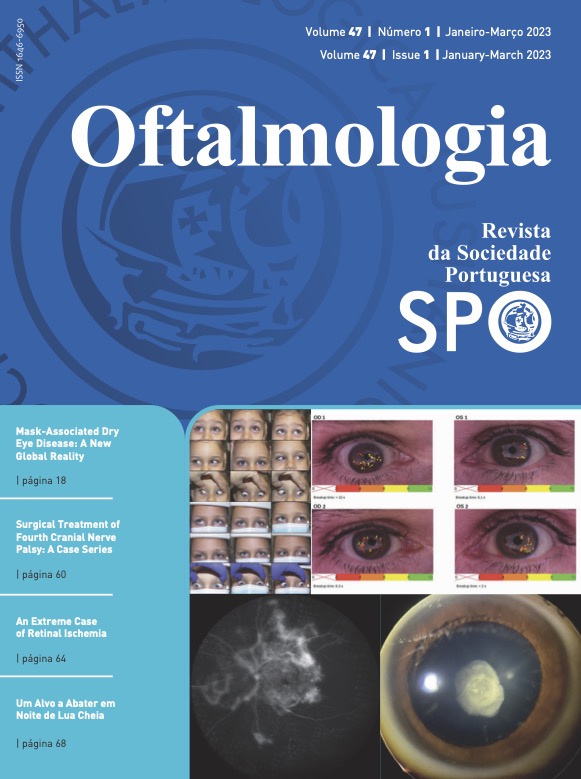Incidence and Predictors of Radiation Retinopathy after I125 Plaque Brachytherapy for the Treatment of Choroidal Melanoma
DOI:
https://doi.org/10.48560/rspo.25970Keywords:
Brachytherapy/adverse effects, Choroid Neoplasms/radiotherapy, Iodine Radioisotopes/adverse effects, Melanoma/radiotherapy, Retina/radiation effectsAbstract
INTRODUCTION: Plaque brachytherapy is an established modality for the treatment of eligible choroidal melanomas. Radiation retinopathy (RR) is a known complication of brachy- therapy, responsible in part for the loss of vision after treatment. We aim to present the first report on the incidence and the predictors of radiation retinopathy after the treatment of choroidal mela- nomas in the Portuguese Ocular Oncology Reference Centre.
METHODS: Retrospective case series of eligible choroidal melanoma patients submitted to plaque brachytherapy with I125 in the Ocular Oncology Unit of the Coimbra University and Hos- pital Centre (CHUC) between 2013-2021. Clinical, tumor and treatment variables were collected. Primary endpoints were defined as the cumulative incidence and the incidence rate of RR. Sec- ondary endpoints were the clinical predictors of RR as obtained through multivariable logistic regression. Candidate variables were determined through univariate logistic regression, based on clinical and an α level of 0.15. Using these variables, we built a stepwise multivariable logistic regression model, for which we considered an α level of 0.05.
RESULTS: We included 150 eyes of 150 patients, mean aged 61.1±13.3 years and a median follow-up time of 33.5 months (15-52). Incidence rate of RR was 2.14/100 person-years, and the cu- mulative incidence of radiation retinopathy was 44.7% (67/150). Median time to RR development was 13 (7-18) months. Multivariable logistic regression revealed increased odds of RR with higher baseline tumor thickness (OR 1.39; 1.17-1.65; p<0.01), decreased odds of RR with pre-equator lo- cation of the tumor (OR 0.32; 0.11-0.95; p=0.04), and a trend towards decreased odds of RR with increasing age (OR 0.97; 0.95-1.00; p=0.07).
CONCLUSION: The incidence of radiation retinopathy in our cohort agrees with results of published landmark trials in plaque brachytherapy. Increased baseline tumor thickness increased the odds of RR, while pre-equatorial location protected against RR and increased age showed a trend towards a protective effect.
Downloads
References
Jager MJ, Shields CL, Cebulla CM, Abdel-Rahman MH, Grossniklaus HE, Stern M-H, et al. Uveal melanoma. Nat Rev Dis Primers. 2020;6:24. doi: 10.1038/s41572-020-0158-0.
Le BHA, Kim JW, Deng H, Rayess N, Jennelle RL, Zhou SY, et al. Outcomes of choroidal melanomas treated with eye physics plaques: A 25-year review. Brachytherapy. 2018;17:981–9. doi: 10.1016/j.brachy.2018.07.002.
Collaborative Ocular Melanoma Study Group. The COMS randomized trial of iodine 125 brachytherapy for choroidal melanoma: V. Twelve-year mortality rates and prognostic factors: COMS report No. 28. Arch Ophthalmol. 2006;124:1684– 93. doi: 10.1001/archopht.124.12.1684.
Archer DB, Amoaku WM, Gardiner TA. Radiation retinopathy-clinical, histopathological, ultrastructural and experimental correlations. Eye. 1991;5:239–51. doi: 10.1038/ eye.1991.39.
Sahoo NK, Ranjan R, Tyagi M, Agrawal H, Reddy S. Radiation retinopathy: detection and management strategies. Clin Ophthalmol. 202;15:3797–809. doi: 10.2147/OPTH.S219268.
Melia BM, Abramson DH, Albert DM, Boldt HC, Earle JD, Hanson WF, et al. Collaborative ocular melanoma study (COMS) randomized trial of I-125 brachytherapy for medium choroidal melanoma. I. Visual acuity after 3 years COMS report no. 16. Ophthalmology. 2001;108:348–66. doi: 10.1016/ s0161-6420(00)00526-1.
Shields CL, Shields JA, Cater J, Gündüz K, Miyamoto C, Micaily B, et al. Plaque radiotherapy for uveal melanoma: long-term visual outcome in 1106 consecutive patients. Arch Ophthalmol. 2000;118:1219–28. doi: 10.1001/archopht.118.9.1219.
Gündüz K, Shields CL, Shields JA, Cater J, Freire JE, Brady LW. Radiation retinopathy following plaque radiotherapy for posterior uveal melanoma. Arch Ophthalmol. 1999;117:609– 14. doi: 10.1001/archopht.117.5.609.
Bianciotto C, Shields CL, Pirondini C, Mashayekhi A, Furuta M, Shields JA. Proliferative radiation retinopathy after plaque radiotherapy for uveal melanoma. Ophthalmology. 2010;117:1005–12. doi: 10.1016/j.ophtha.2009.10.015.
Patel KR, Prabhu RS, Switchenko JM, Chowdhary M, Craven C, Mendoza P, et al. Visual acuity, oncologic, and toxicity outcomes with 103Pd vs. 125I plaque treatment for choroidal melanoma. Brachytherapy. 2017;16:646–53. doi: 10.1016/j. brachy.2017.01.012.
Shields CL, Dalvin LA, Chang M, Mazloumi M, Fortin P, McGarrey M, et al. Visual Outcome at 4 Years Following Plaque Radiotherapy and Prophylactic Intravitreal Bevacizumab (Every 4 Months for 2 Years) for Uveal Melanoma: Comparison With Nonrandomized Historical Control Individuals. JAMA Ophthalmol. 2020;138:136–46. doi: 10.1001/jamaophthalmol.2019.5132.
De Lott LB, Burke JF, Andrews CA, Costello F, Cornblath WT, Trobe JD, et al. Association of Individual-Level Factors With Visual Outcomes in Optic Neuritis: Secondary Analysis of a Randomized Clinical Trial. JAMA Netw Open. 2020;3:e204339. doi: 10.1001/jamanetworkopen.2020.4339.
Lange C, Feltgen N, Junker B, Schulze-Bonsel K, Bach M. Resolving the clinical acuity categories “hand motion” and “counting fingers” using the Freiburg Visual Acuity Test (FrACT). Graefes Arch Clin Exp Ophthalmol. 2009;247:137– 42. doi: 10.1007/s00417-008-0926-0.
Echegaray JJ, Bechrakis NE, Singh N, Bellerive C, Singh AD. Iodine-125 Brachytherapy for Uveal Melanoma: A Systematic Review of Radiation Dose. Ocul Oncol Pathol. 2017;3:193–8. doi: 10.1159/000455872.
American Brachytherapy Society - Ophthalmic Oncology Task Force. Electronic address: paulfinger@eyecancer.com, ABS – OOTF Committee. The American Brachytherapy Society consensus guidelines for plaque brachytherapy of uveal melanoma and retinoblastoma. Brachytherapy. 2014;13:1–14. doi: 10.1016/j.brachy.2013.11.008.
Yang X, Dalvin LA, Mazloumi M, Chang M, Shields JA, Mashayekhi A, et al. Impact of uveal melanoma thickness on post-plaque radiotherapy outcomes in the prophylactic anti-vascular endothelial growth factor era in 1131 patients. Clin Experiment Ophthalmol. 2020;48:610–23. doi: 10.1111/ ceo.13758.
Downloads
Published
How to Cite
Issue
Section
License
Copyright (c) 2023 Revista Sociedade Portuguesa de Oftalmologia

This work is licensed under a Creative Commons Attribution-NonCommercial 4.0 International License.
Do not forget to download the Authorship responsibility statement/Authorization for Publication and Conflict of Interest.
The article can only be submitted with these two documents.
To obtain the Authorship responsibility statement/Authorization for Publication file, click here.
To obtain the Conflict of Interest file (ICMJE template), click here





